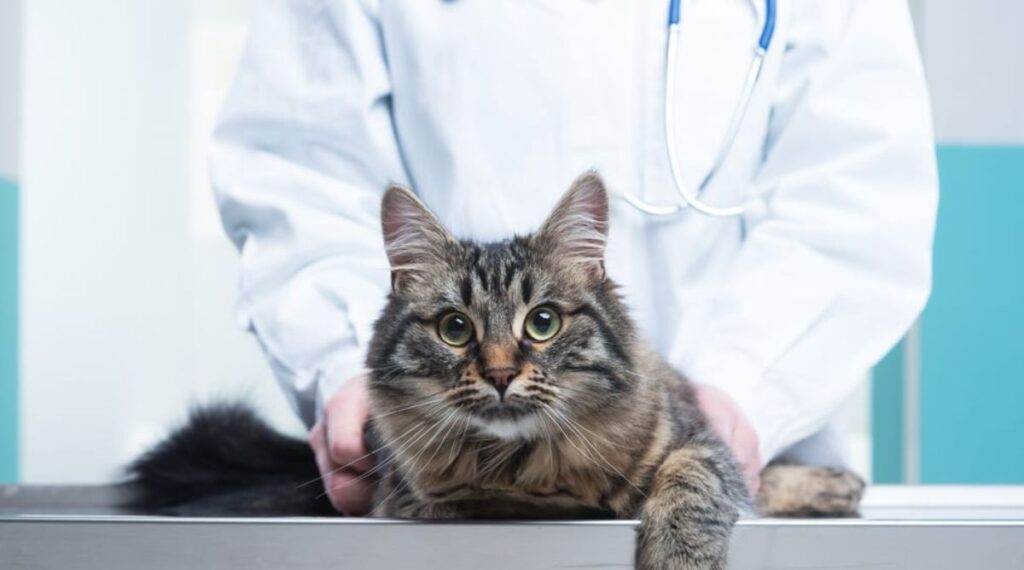Generally, this ailment can be found in both young and old cats, though, older cats are usually at a higher risk. Since these internalized tumours can adversely affect the quality of life for cats, care should be taken. Brain tumours in cats range anywhere from benign to malignant and cannot be caught easily due to the lack of external symptoms.
The most frequent type of brain tumour found in cats, meningioma, is usually benign, whereas gliomas and lymphosarcoma tend to be severe. As pressure builds in the skull due to the tumour, the cat’s brain starts to get pushed down which gives birth to several problematic neurological symptoms.
While the capability of a cat appearing on a screen in a vet clinic looks intriguing, most spend a fortune on these advanced treatments and scanners to make or break the health of their cats. This isn’t the case, so owners should come up with proper means to ensure their cats are living healthily.
Definition of Brain Tumors in Cats
Brain Tumors in Cats is defined as a neoplasm occurring in brain cells in abnormal patterns and is said to be moderately impactful to our furry companions.
Tumors can be described as either primary or secondary:
Primary Brain Tumors: These tumours develop within the brain itself or surrounding tissues, and include but are not limited to meningiomas, gliomas, and choroid plexus tumours.
Secondary Brain Tumors: These tumours arise through metastasis from other cancerous organs like lungs, breasts, etc. Brain Tumors in Cats are not common but that doesn’t mitigate the severity of the health complications a cat might undergo. The direct etiological factor of brain tumours is still owed to controversy, but genetics, age, and environment seem to play an influential role.
Symptoms of Brain Tumors in Cats
The symptoms of brain tumours in cats largely depend on the size and location of the tumour. The following signs remain common in most cats that are diagnosed with a brain tumour:
Seizures: One of the first signs cat owners observe is frequent unexplained cat seizures. During this, cats can twitch, jerk, or ultimately lose consciousness.
Behavioural Changes: Cats may also become aggressive, or intolerable, or may show signs of physical tiredness. These changes are signs of stress and anxiety.
Vision Problems: Cats’ poor vision can further impair their movement and reflexes, making them prone to collisions with various objects, and their pupils can become dilated.
Loss of Coordination: Cats may show trouble maintaining balance and walking, and exhibit signs showcasing weakness.
A head tilt is someone tilting their heads. This can potentially be an indicator of cancerous masses on the brain affecting balance and posture. Some cats with tumours may demonstrate the behaviour of walking in circles or pacing back and forth, as these activities may tend to calm them down. This is especially true when the tumour is located in the forebrain.
Make sure you bring your feline friend to the veterinarian immediately to rule out the possibility that they are having a brain tumour.
Brain Tumor Diagnosis in Cats
A lack of advanced scanning technology may render a diagnosis for cats a bit complicated. Performing these blood tests is highly recommended to rule out any Brain Tumors in Cats:
Physical exams: Conducting comprehensive physical and neurological evaluations on the cat includes looking for any possible anomalies that could indicate a possible head tumour.
Checking blood: A wide range of routine blood tests can help rule out any underlying problems with the organs.
Imaging: CT scans and MRIs can easily detect the presence and precise location of the brain tumour.
Biopsy: With the help of a tumour biopsy, it is possible to identify what type of brain tumour is growing. Remain proactive in your cat’s health as early detection is crucial for treatment intervention.
Brain Tumor Treatment Options in Cats
Various factors like overall health, types and location of the tumour greatly determine tumour treatment in cats.
Possible treatment options:
Surgery: Some tumours are reachable, and the best chance of eliminating them is through surgery. A good example would be meningiomas, which are optimistic in that they might be taken out fully, thus having a better outcome.
Radiation therapy: Tumor shrinkage is a possibility with this treatment; likewise, it alleviates tumour symptoms. Isolated, this treatment is often administered when surgical procedures are either impractical or the tumour can’t be removed entirely.
Chemotherapy: It is not often used with Brain Tumors in Cats, but it is a possibility within some types of tumours like lymphosarcoma.
Palliative care: Advanced tumours within cats or the ones that have not responded well to treatment are the ones where palliative care is provided. Symptoms are managed while life quality is improved through medication to lessen brain swelling and pain alleviation.
Prognosis for Cats with Brain Tumors
There are many different things to look out for when a cat is suffering from a Brain Tumors in Cats. The most important ones are finding out which kind of tumour it is, the treatment done for it, and where it is positioned. Some cats that have meningioma and are benign tend to do well as they survive with the help of minimal care. Contrary to those with malignant tumours who have a shorter life expectancy. Adjustments to their condition require regular check-ups.
Living with a Cat Diagnosed with a Brain Tumor
Both physically and emotionally, it is hard to care for a cat with a Brain Tumors in Cats.
Here are some tips for caring for your cat’s well-being:
Monitor Symptoms: It is important to keep close tabs on your cat and their changing behaviours and symptoms. If anything unusual is spotted, it is wise to consult with your vet.
Create a Comfortable Environment: Ensure that your cat is placed in a low-pressure environment where they can strive to get some rest. Having comforting familiar items such as toys and blankets can help reduce some stress.
Follow Treatment Plans: Always follow the treatment and medication plans as best as your vet instructed. It is essential to conduct regular follow-ups in order to assess what is going on with the cat.
Consider Palliative Care: Discuss how to maintain quality of life with your vet so that your feline is at ease while you get through more serious situations.
Understanding the Types of Brain Tumors in Cats
Meningiomas: This is the classification with the most prevalent Brain Tumors in Cats. These tumours come from the protective membranes that surround the brain (meninges). Some meningiomas are considered benign; however, due to their position, they can cause important symptoms. These tumours can be more aggressive than the ones previously mentioned, Meningiomas, because, for these, more treatment may be required.
Lymphosarcoma: These tumours can also be linked to the feline leukaemia virus and may occur in the brain. Lymphosarcoma is a malignant tumour and due to that, it often requires chemotherapy.
Choroid Plexus Tumors: These tumors come from the choroid plexus which is the area that makes cerebrospinal fluid. So it may be needed to have a surgical intervention and it may or not be a death sentence.
These tumours have an effect on the pituitary gland, a critical endocrine organ in the body that regulates various functions throughout the body via the release of hormones. Hormone disorders, which are the consequence of the tumour imbalance, are common among those suffering from pituitary tumours and require targeted treatments.
Factors that may expose your cat to the risk of developing brain tumours.
The specific causes of the development of Brain Tumors in Cats are not very clear, but some factors look like they increase the chances of these tumours occurring:
Age: The problem increases with age, cats older than 10 years of age definitely develop a lot more brain tumours than younger cats.
Breed: Certain breeds are more susceptible to certain categories of brain tumours. An example would be the Siamese breed of cats which have been noted to develop meningiomas more than other breeds.
About gender: Studies suggest that male felines tend to be more predisposed to brain tumours when compared to their female counterparts. However, this area has not been extensively explored.
How Come You Need To Visit A Veterinary Clinic Often For Your Feline Companion?
Regular check-up visits for your feline companion can help prevent most of the serious health issues such as cat brain tumours that may arise. With each visit, the vet can conduct the preliminary physical examination and if something seems out of place, run some tests. Addressing issues at an early stage means there’s a higher chance of brain tumour management success in cats.
Emotional Support For Pet Owners
Affected by Illness It’s true that pet owners face a lot of challenges when it comes to dealing with Brain Tumors in Cats. It is necessary to reach out to family, friends, and even support groups specifically for owners of sick pets. This allows them to share and for some people, vent about the painful experiences of having a sick cat and helps ease the emotional distress associated with it.
Conclusion: Brain Tumors in Cats
Cats that demonstrate signs suggestive of a Brain Tumors in Cats should be taken for medical care where relevant action can be taken. An owner who knows his or a day’s ailment’s signs, symptoms, diagnosis, and treatment can take good care of his or her pet. It is important to attend consultations and follow-ups with veterinarians regularly for prompt diagnosis and treatment of brain tumours in cats. More attention and participation in an animal’s care will guarantee that they are well taken care of.
FAQs: Brain Tumors in Cats
Does Any Cat Develop Brain Tumors?
Brain tumours are uncommon in cats. Less than 2% of all tumours in cats are brain tumours. Many of these tumours go undiagnosed simply because they do not have easy detection options.
Do Cancerous Cats Show Any Symptoms?
Symptoms can vary, but common features are habitual changes like pacing more than usual, circling, vision loss, seizures, inability to move properly, and even a head tilt.
How To Treat Cats Suffering From Brain Tumours?
Treatment of Brain Tumors in Cats often includes surgery, chemotherapy, palliative care, radiation, and sometimes, simply ease the suffering of the animal. However, the type and the position of the tumour greatly influence treatment options.
Brain Tumours On Cats, What Is The Life Expectancy?
The type of further treatment in hand after the diagnosis will determine the outcome and prognosis. After treatment, some cats can live for several years but others with a shorter life span might succumb to their condition.
Can Cats Get Brain Tumors And How Can They Be Prevented?
Unfortunately, there are no effective prevention methods for most feline brain tumours. Avoiding injury is usually much more effective than having to plan for a treatment and your cat ought to see the vet routinely from an early age since brain tumours might form at any age after infancy.







